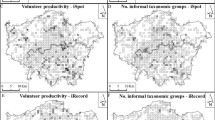Abstract
There is a pressing need for volunteer amateur naturalists to participate in data collection for biodiversity monitoring programmes in Europe. It is being addressed in some countries, but less so in others. This paper discusses the results from qualitative research using semi-structured interviews, focus groups and participant observation within nine Participatory Monitoring Network (PMN) organisations in six European countries. The paper examines the features that facilitate recruitment, retention and motivations of volunteers to participate in biodiversity monitoring, including the social and cultural milieus in which they operate. The paper concludes that volunteers place a high degree of significance on their social experience within PMNs. Successful creation and management of PMNs thus requires that similar levels of attention be paid to social aspects of the organisation as are paid to the generation and management of data.
Similar content being viewed by others
References
Battersby JE, Greenwood JD (2004) Monitoring terrestrial mammals in the UK: past, present and future, using lessons from the bird world. Mammal Rev 34(1–2):3–29
Bell S, Marzano M, Podjed D (in press) Inside monitoring: A comparison of bird monitoring groups in Slovenia and the United Kingdom. In: Lawrence A (ed) Taking stock of nature. Cambridge University Press, Cambridge
Burnett J, Copp C, Harding P (1995) Biological recording in the United Kingdom: Present practice and future development—Summary report. Department of the Environment, London
Danielsen F, Burgess ND, Balmford A (2005) Monitoring matters: examining the potential of locally-based approaches. Biodivers Conserv 14(11):2507–2542
DeWalt KM, DeWalt BR (2002) Participant observation: a guide for fieldworkers. University of Chicago Press, Chicago
Ellis C (2003) When volunteers pay to take a trip with scientists—Participatory Environmental Research Tourism (PERT). Hum Dimens Wildl 8(1):75–80
Ellis R, Waterton C (2005) Caught between the cartographic and the ethnographic imagination: The whereabouts of amateurs, professionals, and nature in knowing biodiversity. Environ Plan D 23(5):673–693
Emerson RM, Fretz RI, Shaw LL (1995) Writing ethnographic fieldnotes. Altamira Press, Oxford
Harris KJ, Jerome NW, Fawcett SB (1997) Rapid assessment procedures: A review and critique. Hum Organ 56(3):375–378
Jardine N, JA Secord, Spray EC (eds) (1996) Cultures of natural history. Cambridge University Press, Cambridge
Kempton W, Holland DC, Bunting-Howarth K, Hannan E, Payne C (2001) Local environmental groups: a systematic enumeration in two geographical areas. Royal Sociology 66(4):557–578
Lawrence A (2005) Reluctant citizens? The disjuncture between participatory biological monitoring and environmental governance. Paper presented at the International Sociology Association Conference ‘Environmental knowledge and democracy’, Luminy, France, 6–7 July 2005
Lawrence A, Turnhout C (2005) Personal meaning in the public space: The bureaucratisation of biodiversity data in the UK and the Netherlands. Paper presented at the RGS-IBG Annual conference, London, UK, 31 August 2005
McKelvey B (1975) Guidelines for the empirical classification of organisations. Adm Sci Q 20(4):509–525
MESP (2002) Strategija ohranjanja biotske raznovrstnosti v Sloveniji. (Biodiversity Conservation Strategy of Slovenia). Ministry of the Environment and Spatial Planning of the Republic of Slovenia, Ljubljana
Moss S (2004) A Bird in the bush: a social history of birdwatching. Aurum Press, London
PAMEB (2003) Policy Brief. Environmental Change Institute, Oxford
Shumar W, Renniger KA (2002) Building virtual communication: learning and change in cyberspace. Cambridge University Press, Cambridge
Stebbins RA (1992) Amateurs, professionals, and serious leisure. McGill-Queen’s University Press, London and Montreal
Stebbins RA (2001), New directions in the theory and research of serious leisure. Edwin Mellen Press, Lampeter
Willets P (n.d) What is a non-governmental organization? UNESCO Encyclopedia of Life Support Systems, Section 1 Institutional And Infrastructure Resource Issues, Article 1.44.3.7, Non-Governmental Organizations
Author information
Authors and Affiliations
Corresponding author
Rights and permissions
About this article
Cite this article
Bell, S., Marzano, M., Cent, J. et al. What counts? Volunteers and their organisations in the recording and monitoring of biodiversity. Biodivers Conserv 17, 3443–3454 (2008). https://doi.org/10.1007/s10531-008-9357-9
Received:
Accepted:
Published:
Issue Date:
DOI: https://doi.org/10.1007/s10531-008-9357-9




